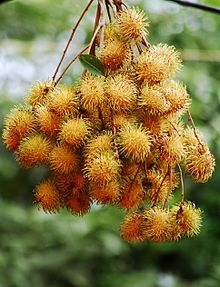RAMBUTAN - Part 1
 The rambutan (taxonomic name: Nephelium lappaceum) is a medium-sized tropical tree in the family Sapindaceae, and the fruit of this tree. It is native to Indonesia, Malaysia, The Philippines, Sri Lanka and elsewhere in Southeast Asia, although its precise natural distribution is unknown. It is closely related to several other edible tropical fruits including the Lychee, Longan, and Mamoncillo. It is believed to be native to the Malay Archipelago, from where it spread westwards to Thailand, Burma, Sri Lanka and India; eastwards to Vietnam, the Philippines and Indonesia.
The rambutan (taxonomic name: Nephelium lappaceum) is a medium-sized tropical tree in the family Sapindaceae, and the fruit of this tree. It is native to Indonesia, Malaysia, The Philippines, Sri Lanka and elsewhere in Southeast Asia, although its precise natural distribution is unknown. It is closely related to several other edible tropical fruits including the Lychee, Longan, and Mamoncillo. It is believed to be native to the Malay Archipelago, from where it spread westwards to Thailand, Burma, Sri Lanka and India; eastwards to Vietnam, the Philippines and Indonesia.Rambutan are non-climacteric fruit - that is, they refuse to ripen unless on the tree. Local rambutan has various type. The fruits are in red, pink and yellow color. The taste are also different, from sweet up to sour one. Rambutan fruits normally can split the flesh and the seeds easily when eaten. There are also rambutan fruits which never allow the flesh leaving the seeds. This type of rambutan is a bit smaller in size, yet sweet and delicious in taste. Some local people will swallow the flesh together with the seeds when eating it. They are very good for rambutan jams.

No comments:
Post a Comment